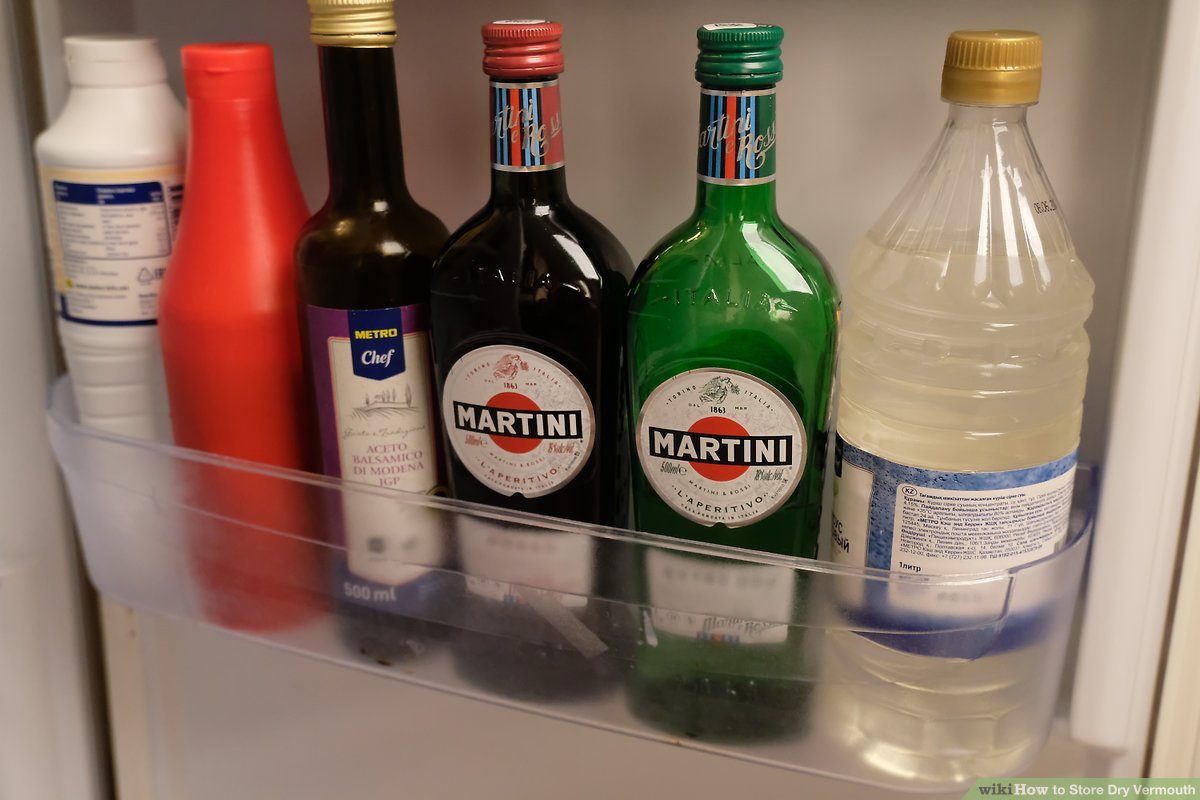Did you ever wonder how long that bottle of vermouth sitting in your liquor cabinet will actually last?
Vermouth, the beloved fortified wine infused with aromatic herbs and spices, is not only a key ingredient in classic cocktails, but also a delightful aperitif on its own.
But how long can you expect this flavorful elixir to maintain its freshness once it’s been uncorked?
Stay tuned as we uncover the secret behind vermouth’s shelf life, and guarantee you’ll be sipping in no time.
how long does vermouth last
Once opened, vermouth typically lasts for around 3 to 6 months.
Vermouth is a fortified wine with an alcohol by volume (ABV) of 16-22%, which helps it last longer than regular wine.
However, its shelf life begins to slowly count down once the bottle is opened.
Proper storage is crucial to keep vermouth fresh and maintain its flavor.
Using vermouth that has gone off in a cocktail will result in a sub-par drink.
To keep vermouth at its best, both dry and sweet varieties should be stored in the refrigerator, tightly sealed, and ideally consumed within a few months of opening.
Key Points:
- Vermouth typically lasts for 3 to 6 months once opened.
- Vermouth has a higher alcohol content than regular wine, which helps it last longer.
- Shelf life of vermouth begins to decrease after opening.
- Proper storage is important for maintaining vermouth’s freshness and flavor.
- Using expired vermouth in cocktails will result in a lower quality drink.
- Vermouth should be stored in the refrigerator, tightly sealed, and ideally consumed within a few months of opening.
how long does vermouth last – Watch Video


Pro Tips:
1. Vermouth, a fortified wine, can last for up to a year after opening if stored properly in the refrigerator. However, it is best consumed within 3-6 months to maintain its freshness and flavor.
2. Vermouth actually originated in Turin, Italy in the late 18th century and was initially used for medicinal purposes before becoming a popular ingredient in cocktails.
3. In the early 19th century, a Turin-based herbalist named Antonio Benedetto Carpano is credited with creating the first vermouth. His recipe included a secret blend of herbs and spices infused in white wine.
4. Vermouth is a key component of classic cocktails such as the Martini and the Negroni. A dry vermouth is typically used in a Martini, while a sweet vermouth is used in a Negroni.
5. Vermouth is commonly divided into two main categories: sweet (red) vermouth and dry (white) vermouth. However, there are also variations like bianco vermouth (a white vermouth with added vanilla flavors) and rosé vermouth (a blend of red and white vermouth).
Vermouth And Its Alcohol Content
Vermouth is a type of fortified wine that typically has an alcohol by volume (ABV) ranging from 16% to 22%. This relatively low alcohol content is a defining characteristic of vermouth and sets it apart from other spirits like vodka or whiskey. The lower ABV makes vermouth a popular choice for those looking for a lighter and more refreshing beverage.
The alcohol content in vermouth serves several purposes. Firstly, it acts as a preservative, helping to extend the shelf life of the drink. Secondly, it serves as a carrier for the flavors and aromas of the botanicals and other ingredients used in the production of vermouth. Finally, the alcohol gives vermouth its characteristic warming effect on the palate when consumed.
- Vermouth is a type of fortified wine
- Vermouth has an alcohol by volume (ABV) ranging from 16% to 22%
- The lower ABV makes vermouth a popular choice for a lighter and more refreshing beverage
- The alcohol content in vermouth acts as a preservative, extending its shelf life
- The alcohol serves as a carrier for the flavors and aromas of the botanicals and other ingredients in vermouth
- Vermouth provides a warming effect on the palate when consumed
Shelf Life Of Opened Vermouth
Once opened, the shelf life of vermouth begins to slowly count down. While some sources may suggest that vermouth can last indefinitely, it is generally recommended to consume vermouth within three to six months of opening. This is because exposure to oxygen can cause the flavors and aromas of vermouth to degrade over time, resulting in a less enjoyable drinking experience.
To extend the shelf life of opened vermouth, it is important to store it properly. The best way to do this is to keep the vermouth refrigerated after opening. Cold temperatures help slow down oxidation and maintain the freshness of the drink. Additionally, always make sure to tightly seal the bottle after each use to minimize the contact with oxygen.
- Store opened vermouth in the refrigerator
- Seal the bottle tightly after each use
The Ingredients Of Vermouth
Vermouth is a blend of wine and botanicals, with wormwood being a standard ingredient. Wormwood is a bitter herb that gives vermouth its distinctive flavor. Other common botanicals include gentian root, angelica, coriander, and citrus peel. The combination of these botanicals, along with the base wine used, gives vermouth its unique taste profile.
The production of vermouth involves macerating the botanicals in the base wine, which allows the flavors and aromas to infuse. Some producers may also add sweeteners such as sugar or caramel to balance the bitterness of the wormwood. The exact ingredients and proportions used can vary widely between different vermouth brands, resulting in a diverse range of flavors and styles.
- Vermouth is a blend of wine and botanicals
- Wormwood is a bitter herb that gives vermouth its distinctive flavor
- Common botanicals include gentian root, angelica, coriander, and citrus peel
- Macerating the botanicals in the base wine allows the flavors and aromas to infuse
- Some producers add sweeteners like sugar or caramel to balance the bitterness
- Varying ingredients and proportions create diverse flavors and styles.
Ways To Consume Vermouth
Vermouth can be enjoyed in a variety of ways. It is commonly served as an aperitif, either on its own or with a splash of soda water and a twist of citrus peel. Vermouth’s low alcohol content and flavorful profile make it a refreshing choice to stimulate the appetite before a meal.
Additionally, vermouth is a popular ingredient in cocktail making. It is an essential component in classics such as Manhattans, martinis, and Negronis. In these cocktails, vermouth adds depth, complexity, and a touch of sweetness. The botanical notes of vermouth also complement the flavors of other spirits and mixers, creating a harmonious balance in the drink.
For those who prefer a simpler and more casual way of enjoying vermouth, it can be served over ice with a slice of citrus fruit as a refreshing and low-alcohol alternative. This allows the full range of flavors to shine through without the complexity of a cocktail.
- Vermouth is commonly served as an aperitif
- It can be enjoyed on its own or with soda water and citrus peel
- Vermouth is an essential component in classic cocktails
- It adds depth, complexity, and sweetness to cocktails
- Vermouth’s botanical notes complement other spirits and mixers
- Enjoy vermouth over ice with citrus fruit for a refreshing alternative
Ancient Origins Of Vermouth
The history of vermouth can be traced back to Ancient Greece, where it was initially developed as a medicinal remedy. This early form of vermouth utilized ingredients such as wormwood and other botanicals, which were believed to possess therapeutic properties. As time went on, however, vermouth transitioned from being a mere medicinal concoction to becoming a beverage cherished for its delightful flavor.
Verdict:
- Vermouth has a long-standing history that can be traced back to Ancient Greece.
- Initially created for medicinal purposes, vermouth contained ingredients like wormwood and other botanicals.
- Over time, it evolved into a popular beverage enjoyed for its taste.
Monastic Influence On Vermouth Production
During the Middle Ages, monks played a crucial role in advancing and spreading the production of vermouth. They dedicated themselves to refining and developing vermouth recipes, ultimately making it a staple in monastic communities across Europe.
The monasteries had abundant access to herbs and botanicals, allowing the monks to experiment and create new variations of vermouth. Their expertise and dedication led to the establishment of renowned vermouth production in many monasteries.
Today, several famous vermouth brands can trace their roots back to these monastic traditions, carrying on the legacy of the talented monks who perfected the craft.
Some key points to note:
- Monks played a significant role in advancing vermouth production.
- Vermouth became a staple in monastic communities during the Middle Ages.
- Monasteries had access to plentiful herbs and botanicals, enabling experimentation.
- Famous vermouth brands today have their origins in monastic traditions.
“Monks dedicated themselves to refining and developing vermouth recipes, ultimately making it a staple in monastic communities across Europe.”
- Monastic influence on vermouth production spanned centuries, with many monasteries gaining recognition for their expertise.
Updated text:
During the Middle Ages, monks played a crucial role in advancing and spreading the production of vermouth. They dedicated themselves to refining and developing vermouth recipes, ultimately making it a staple in monastic communities across Europe. The monasteries had abundant access to herbs and botanicals, allowing the monks to experiment and create new variations of vermouth. Their expertise and dedication led to the establishment of renowned vermouth production in many monasteries.
Today, several famous vermouth brands can trace their roots back to these monastic traditions, carrying on the legacy of the talented monks who perfected the craft.
- Monks played a significant role in advancing vermouth production.
- Vermouth became a staple in monastic communities during the Middle Ages.
- Monasteries had access to plentiful herbs and botanicals, enabling experimentation.
- Famous vermouth brands today have their origins in monastic traditions.
Vermouth’s Role In Cocktail Making
Vermouth plays a crucial role in cocktail making, adding depth and complexity to a wide range of drinks. It is an essential ingredient in classics such as the Manhattan, which combines vermouth with whiskey and bitters, and the martini, which traditionally pairs vermouth with gin. The sweet and bitter elements of vermouth also make it a key component in the Negroni, a popular Italian cocktail.
The botanicals and herbs used in vermouth provide a myriad of flavors that enhance and elevate the taste of other spirits and mixers. Vermouth’s ability to balance out the alcohol and add unique layers of taste has made it a staple behind bars and in the hands of skilled mixologists.
- Vermouth adds depth and complexity to cocktails.
- It is an essential ingredient in classics like the Manhattan and martini.
- The sweet and bitter elements make it a key component in the Negroni.
- The botanicals and herbs in vermouth enhance the taste of other spirits and mixers.
- Vermouth balances out the alcohol and adds unique flavors.
Enjoying Vermouth In Different Ways
In addition to being used in cocktails, vermouth can also be enjoyed on its own or mixed with soda water. Served chilled, vermouth can be a refreshing aperitif that stimulates the palate before a meal. The combination of the wine base and botanical flavors creates a complex and satisfying drink that can be sipped and savored.
Mixing vermouth with soda water is a popular way to create a lighter and more refreshing beverage. This combination brings out the vibrant flavors of the botanicals and creates a bubbly and effervescent drink that is perfect for warm weather or casual occasions.
- Vermouth can be enjoyed in cocktails, on its own, or mixed with soda water.
- Served chilled, it acts as a refreshing aperitif before a meal.
- The combination of wine base and botanical flavors creates a complex and satisfying drink.
- Mixing vermouth with soda water produces a lighter and more refreshing beverage.
- The vibrant flavors of the botanicals are accentuated in this combination.
- Perfect for warm weather or casual occasions.
“Vermouth can be a versatile and enjoyable drink, whether in a cocktail or simply on its own.”
The Flavor Ingredients Of Vermouth
The flavor of vermouth is derived from a combination of botanicals, herbs, spices, and other ingredients. Each vermouth brand and style offers a distinctive blend, leading to a diverse range of flavor profiles for enthusiasts to discover.
Common botanicals employed in vermouth production include wormwood, gentian root, angelica, coriander, and citrus peel. These ingredients play a crucial role in shaping the vermouth’s aroma, bitterness, and overall taste. The specific proportions and combinations of these flavors differ across various vermouth brands, resulting in variations in sweetness, dryness, and complexity.
The Fortification And Longevity Of Vermouth
Vermouth is fortified with distilled alcohol, usually grape brandy, to increase its longevity and stability. The addition of alcohol helps to inhibit bacterial growth and prevent spoilage, allowing the vermouth to last longer than regular wine.
However, despite the fortification, vermouth is still a perishable product. Once opened, the contact with oxygen can lead to oxidation, causing the flavors and aromas to deteriorate over time. It is therefore important to store opened vermouth properly to maintain its freshness and flavor.
Proper storage involves:
- Refrigerating the vermouth after opening
- Tightly sealing the bottle to minimize exposure to oxygen
By keeping the vermouth chilled and protected from air, it can retain its quality for three to six months. Using vermouth that has gone off in a cocktail will result in a sub-par drink, as the flavors may be muted or unbalanced.
“In conclusion, vermouth is a versatile and enjoyable drink that can be enjoyed in various ways. Whether sipped on its own, mixed into a cocktail, or combined with soda water, vermouth offers a range of flavors and aromas that can tantalize the taste buds. Understanding its shelf life and proper storage is essential to ensure the best drinking experience. So, stock up your bar, experiment with different vermouth styles, and savor the history and flavor of this ancient drink.”

You may need to know these questions about how long does vermouth last
How long does vermouth last out of the fridge?
The lifespan of vermouth can vary depending on its purpose and storage conditions. When used solely for cooking, vermouth stored at room temperature will typically remain good for a few months before experiencing a decline in taste. However, if your intention is to enjoy it for drinking, you should consume the vermouth within one month if it is stored at room temperature. Proper storage techniques, such as refrigeration, can help extend the lifespan and retain the flavor of vermouth for a longer period.
Do you really need to refrigerate vermouth?
Yes, refrigerating vermouth is indeed necessary. Being a fortified wine, vermouth is prone to oxidation once opened. To preserve its flavors and extend its shelf life, it is recommended to store vermouth in the refrigerator. The cool temperature helps slow down the oxidation process, maintaining the integrity of the liquid for a longer period. By refrigerating vermouth, you can ensure that each pour remains as delicious as the last.
Does dry vermouth have a shelf life?
Dry vermouth does indeed have a shelf life, but that doesn’t mean it can’t last for a decent amount of time. While it is best consumed within 3 to 4 years of bottling, dry vermouth can still be enjoyed after that period, especially if stored properly in a pantry or wine cellar. If there is a best-by date indicated on the bottle, adding 2 to 3 years to that date should provide a good estimate of its potential shelf life. So, while it is recommended to use dry vermouth within a few years, it doesn’t necessarily mean it becomes undrinkable after that time.
How do you keep vermouth from going bad?
To ensure the freshness and longevity of vermouth, storing it in the refrigerator is essential. The cold temperature helps prevent oxidation, preserving the delicious flavors of both sweet and dry vermouth. So, though it may not be as visually appealing as displaying it on your bar cart, sacrificing a little aesthetics for the sake of taste is surely worth it.
Reference source
https://www.gq.com/story/how-to-store-vermouth
https://www.tastingtable.com/1128864/how-long-does-dry-vermouth-last-once-opened/
https://www.thecocktailproject.com/Should-Vermouth-Be-Refrigerated
https://www.doesitgobad.com/does-vermouth-go-bad/



